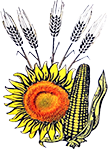Diversification of Sunflower Germoplasm by Using Interspecific Hybridization with Wild Species of the Genus Heliantus
Florin-Gabriel Anton1, Maria Joiţa-Păcureanu1, Diana Văduva1, Luxița Rȋşnoveanu2,3
1Institutul Național de Cercetare-Dezvoltare Agricolă Fundulea
2Stațiunea de Cercetare-Dezvoltare Agricolă Brăila
3Academia de Științe Economice București
Keywords: sunflower, wild species, interspecific hybridization, sunflower downy mildew, broomrape.
Abstract: One of the factors limiting sunflower production is the pathogen Plasmopara halstedii, which produces sunflower downy mildew, as well as the parasitic weed broomrape Orobanche cumana Wallr. It is necessary to identify/create sources of resistance to the disease and the parasite broomrape, made by interspecific hybrids with species of the genus Helianthus, which is a valuable source of resistance genes. The wild sunflower species resistant to the population of the Orobanche cumana parasite from Brăila in 2021, were Helianthus debilis (A4De), Helianthus petiolaris (A5Pe, A6Pe, A7Pe, A8Pe) and Helianthus praecox (A9Pr, A10P) with 0 broomrape/5 sunflower plants, and the most infested were Helianthus annuus (ANN 0340) with 90 broomrape/3 sunfloweer plants and Helianthus nuttallii (NUT-1514-Pl468795) with 22 broomrape/5 sunflower plants. The attack degree of infestation with population of Orobanche cumana parasite from Brăila in 2021, was between 5%, at descendant of 0305C x Helianthus mollis (P9Mo), in the F5 selection generation, and 53% at descendant derived from the interspecific hybrid 1010B x Helianthus debilis (A2De), in the F5 selection generation. The attack degree of infection with the pathogen Plasmopara halstedii, in Fundulea, in 2021, was between 0% at descendants in the F4 selection generation, derived from the interspecific hybrids Arg/84-19669 x Helianthus praecox (A10Pr), NS-H-24 x Helianthus debilis (A3De) and 80% at descendant in the F4 selection generation, derived from the interspecific hybrid Tex.23-602 x Helianthus neglectus (A1Ne). The perennial wild specie Helianthus mollis (P9Mo), contains genes of resistance/tolerance to race G+, of the parasite Orobanche cumana Wallr, and the annual wild species Helianthus praecox (A10Pr) and Helianthus debilis (A3De), contain resistant/tolerant genes at races 304, 314, 710 and 714 of the pathogen Plasmopara halstedii.
